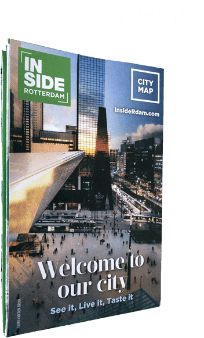The history of Museumpark
[dt_gap height=”10″ /]
Words by Evelien Baks
[dt_gap height=”10″ /]
It was only 100 years ago that the area now widely known as Museumpark was just ordinary farmland. Yet this farmland had far-from-ordinary owners: the extremely wealthy Van Hoboken family. Their old estate now houses six museums, and becoming a very nice place to walk and attend festivals.
[dt_gap height=”10″ /]
Cows once grazed the grassy fields surrounding the 19th-century villa owned by the famous ship-owning family. Their property was a rather odd green oasis sandwiched between several major thoroughfares, including the Westzeedijk, Westersingel and the Coolhaven. When the last resident closed his eyes for the last time back in the 1920’s the estate was shut down for good. The keys were handed over to the municipality of Rotterdam, and the cows probably meeting the same fate as their owners.
[dt_gap height=”10″ /]

The land of the Hoboken family, 1915
[dt_gap height=”10″ /]
As Rotterdammers who amassed their fortune from overseas trading, the Van Hoboken family has left a significant mark on this port city. Of all of them, it was the old port baron, Anthony Van Hoboken (1756-1852 – almost 100 years old at his death) who was particularly rich. His beginnings were humble but he was able to work his way up to become one of Rotterdam’s richest residents. He owned the largest fleet of sailing ships in the Netherlands, had his own wharf, and was also a banker. He made his fortune shipping products such as Gouda pipes, salmon and beer to the East.
[dt_gap height=”10″ /]
With his money he bought property, or rather estates, and became known as the landlord of Rhoon (castle included), Pendrecht and Cortgene. A daughter got to live in the fantastic Buiten Schoonoord on the Parklaan (Scheepvaartkwartier), still beautiful to this day, and a son lived at Villa Welgelegen. Apparently, Willem I once said, ‘If I wasn’t the king then I would want to be a Van Hoboken.’ Anthony Van Hoboken lives on in bronze at Veerhaven, where he keeps good company with, among others, Mr Jamin, the famous Rotterdam confectioner (you can visit a Jamin sweet shop on the Lijnbaan).
[dt_gap height=”10″ /]
Around the mid-1800s, Van Hoboken’s son built Villa Dijkzigt on the family estate directly behind the Westzeedijk. The characterful building with its eight-sided tower and neo-classical stairway still stands proudly there. In more recent times the current owners (the Natural History Museum) added a glass pavilion. That was after the last ‘caretaker’ and accompanying cat colony had departed from the dilapidated house. The museum (a must-see – do go!) still looks out over green fields, minus the cows. By the time the Rotterdam municipality took ownership of the 56-hectare estate it had become encircled by the spreading city and a plan was put in place to convert it into a park where citizens could walk.
[dt_gap height=”10″ /]

[Photo by Ossip van Duivenbode]
[dt_gap height=”10″ /]
Fortunately, that wasn’t the end of the changes. During the 1930’s a number of white villas in Het Nieuwe Bouwen style (in English, Modernist or International Style) sprung up along the edges of the Van Hoboken estate. They stand there unchanged to this day. Two of them house museums: Huis Sonneveld and the Chabot Museum, which showcases the legacy left by the Rotterdam artist Henk Chabot. Huis Sonneveld was designed for one of the directors of the Rotterdam Van Nelle factory, a white colossus that once produced coffee, tea and tobacco and is now a Unesco World Heritage Site.
[dt_gap height=”10″ /]

The Sonneveld House [Photo by Johannes Schwartz]
[dt_gap height=”10″ /]
There are still pleasant walking opportunities in the park, for example, through the fragrant rose garden with its pond behind the Boijmans Van Beuningen Museum, or along the crushed-shell pathway, and in other parts of the Museumpark heading towards the Erasmus University Medical Centre and the neighbouring Kunsthal. It was Rem Koolhaas, architect of the De Rotterdam building, that gave shape to this part of the park.
[dt_gap height=”10″ /]
Within the next year, the Museumpark will accommodate yet another icon – the ‘Shiny Flowerpot’, a 40-metre-high circular depot for the Boijmans Van Beuningen Museum. This striking building will rise up opposite Het Nieuwe Instituut (a platform for architecture and design). And what would Anthony van Hoboken think of all of this? I’m sure the adventurer would be delighted with all the changes that have taken place on his estate.
[dt_gap height=”10″ /]
[Header photo by Ossip van Duivenbode]















